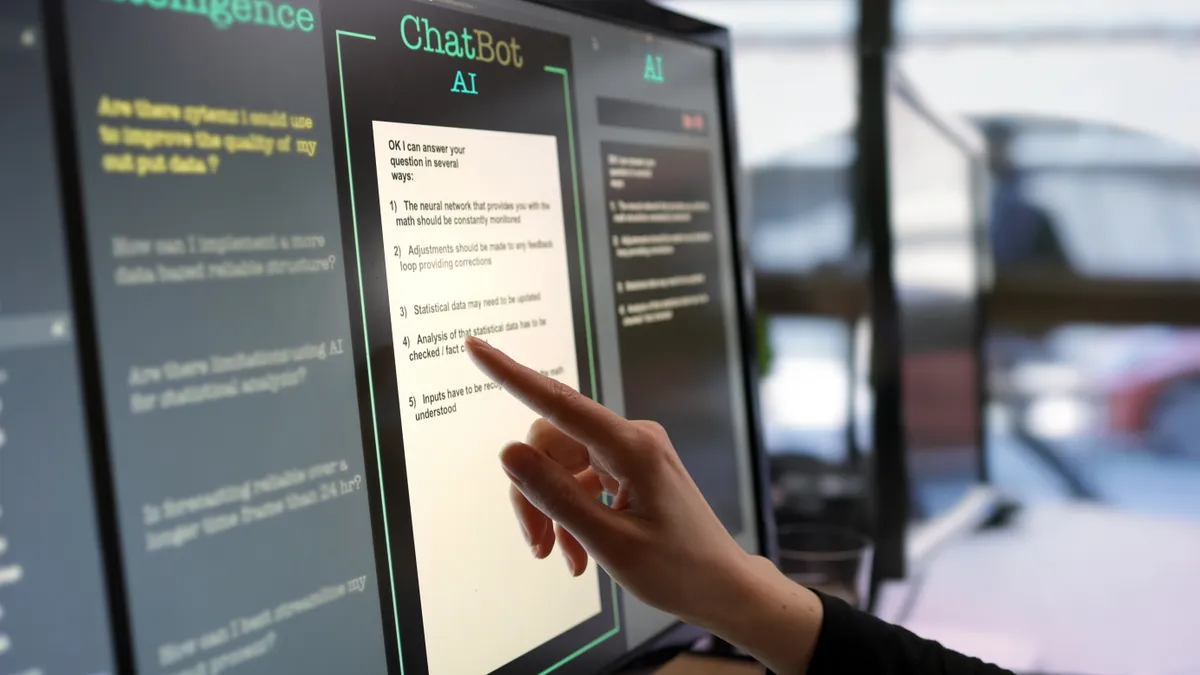PHILADELPHIA — The annual International Society for Technology in Education (ISTE) conference kicked off Monday at the Pennsylvania Convention Center, but as with many years prior, the K-12 IT mega gathering hit the ground running Sunday night with its opening keynote session.
This year’s conference launched with keynotes from Firefly Worldwide Inc. CEO Cheyenne E. Batista, Pixar Director of Photography for Lighting Danielle Feinberg and Tomorrow CEO and “Futuretainment” author Mike Walsh.
But first, an opening video touted the association’s 40th anniversary and its impact advocating for the effective use of technology in the classroom. ISTE CEO Richard Culatta then took the stage to welcome the more than 20,000 attendees, in addition to highlighting the role ISTE’s members and their commitment to evolving with the times have played to the group's longevity.
ISTE Founder David Moursund was also on hand and recognized by Culatta.
We’re here because Dave Moursund brought a group of teachers together to have a conversation #ISTEturns40 #ISTE19 pic.twitter.com/01HUXwf3SA
— ISTE (@iste) June 23, 2019
Batista told of an experience as a young, first-time homebuyer taking a real-estate developer to court for fraud. It was one of many times she had to wrestle down inner messages of self-doubt to succeed, and the example of systemic inequity in that scenario also translates to schools. In the classroom, Batista said, she also frequently asked herself if she did enough for students.
Cheyenne Batista #iste19
— Carol Nelson (@mrscarolnelson) June 23, 2019
Inequity: get urgent, shift what we value, and breathe life into classrooms pic.twitter.com/sJ9vXvudgS
Feinberg followed, telling a story about how she was excited to learn the Pascal computing language in high school. Unfortunately, the class had many of the school's "less-dedicated" students, and the teacher tended to leave the class after roll call — at which point students played computer games. She later studied computer science at Harvard University, where she'd stay up many late hours to get through the “weed out” classes. The courses were also only 10% to 15% women, making her feel like an “other” and that she didn’t belong there.
But she said she was driven by exposure to the Logo computing language as an elementary student. It also didn't hurt that three of her four early computer science teachers were women, in addition to two male professors who treated her like she belonged in their classrooms. This highlights the importance of exposure to role models and support when it comes to getting more women in STEM.
Who does Danielle Feinberg thank for success at @Pixar...? Teachers. Incredible speech. Awe-inspiring experiences that resonate with so many kids that just “don’t fit in” who are destined for greatness with a little help from a teacher #ISTE19 #bethatteacher pic.twitter.com/ddpPdJCSKS
— Anna V. Blake (@annavblake) June 23, 2019
Walsh began with a joke about how difficult it is to explain what a “futurist” is. But in all seriousness, he said there’s a dilemma of collecting data and using artificial intelligence (AI) and machine learning. Students’ content consumption experiences are all algorithmic experiences, collecting data and feeding them recommendations based on that. This, he said, is only a recent development, beginning around 2012.
By 2030, however, the world will be composed of seamlessly orchestrated and personalized experiences made possible by AI platforms, he said — but what does that really mean?
This is best seen in retail, where companies are competing to send people things as soon as they order. The point of big data and AI is to anticipate what people want before they know they want it and deliver it to them.
As a result, it’s time to reinvent, redesign and reimagine, Walsh said. Are people thinking big and fast enough about the power of technology like AI to change education? Is this being considered from students’ frames of reference, with their ideas being included? What would students do differently if they were to design the technology used in their schools or districts — and what might be better or worse?
Educators need not worry about being replaced by AI, he added. Automation will simply change the profession, requiring them to embrace new roles around the tasks that AI eliminates or simplifies.
"The people in your care are literally going to transform the fabric of reality." - Mike Walsh #ISTE19 pic.twitter.com/MazKkKJPR4
— Megan Whitacre (@MeganWhitacre) June 23, 2019
Prepping new student teachers for digital learning
In a Monday morning session, ISTE Standards Senior Director Carolyn Sykora, ISTE Higher Education Recognition Program Lead Reviewer Sarah McPherson and the Fairfield University Graduate School of Education and Allied Professions' Joshua Elliott detailed how ISTE is working with teacher preparation programs to recognize their quality and provide a simpler path to the ISTE Certification for Educators.
According to data from the U.S. Department of Education cited by Sykora, 146,000 graduate degrees in education were awarded in 2016, and there were 451,000 pre-service educators in 2014. The department also made a higher ed policy addendum to its National Education Technology Plan, to which Sykora noted there's a lot of alignment between recommendations and the ISTE Standards for Educators and Students.
That's noteworthy, given that a number of states — including Wisconsin, Michigan, Connecticut, Vermont, Texas, Washington, Delaware, Iowa, Utah, New York, Wyoming and Arkansas — and individual districts are adopting the standards.
ISTE's vision for its higher ed work is to help teacher preparation programs graduate educators with the skills they need to successfully use tech for learning. By targeting pre-service programs, they can reach more educators early in their careers, get the standards in required classes rather than electives, and pivot from referencing the standards to requiring candidates to put the standards into practice, the speakers said.
With the ISTE Higher Ed Recognition Program, teacher prep programs have an additional avenue to be recognized as developing and graduating candidates with skills aligned to those standards. According to information on ISTE's website, it includes:
- Alignment review conducted by ISTE Standards experts, along with a full alignment report.
- Optional consulting services for faculty teams from ISTE Standards experts.
- Recognition from ISTE.
- The opportunity to pursue becoming a higher education ISTE certification provider.
This recognition benefits students by equipping them with tech proficiency, a higher advantage in the job market, and the skills for ed tech leadership roles. For the programs, it can show strengths, weaknesses and areas for change, in addition to making programs stand out and possibly grow enrollment, Elliott said.
At a media breakfast earlier in the morning, ISTE's Culatta also stated that graduates from such programs would need only submit their portfolios to apply for ISTE certification (which was clarified during this session as carrying a $200 fee in this case), rather than going through the normal process. Elliott noted that Fairfield University is "still grappling" with whether to embed certification fees in course costs or to make certification an option that isn't conditional for graduation, with students preparing their portfolios across the four courses involved regardless.
Computational thinking stretches across curriculum
What is computational thinking? How is it different from computer science? Where does it fit in curriculum? How do I measure it?
In an afternoon session, ISTE Computer Science Advisor and Govern For America Co-Founder and CEO Octavia Abell and Friday Institute for Educational Innovation Senior Director for Computer Science Initiatives Dave Frye tackled these questions.
For a closer look, check out our weekly K-12 Curriculum newsletter this Wednesday.
Advocate for the change you seek in your district
Wondering how to raise $20 million for the pilot program you’ve been working on? Struggling to get a seat at the table and play politics for the benefit of your school district?
An afternoon session with two state board of education members and the executive director for the Virginia Society for Technology in Education (VSTE) addressed how school leaders and educators can be effective policy advocates for the change they envision on local and state levels.
Keep an eye out in the coming days for a full recap of the panel.
CTOs return to bootcamp
In what's become one of our favorite recurring IT sessions at the annual ISTE conference, Jeremy Shorr of the Teaching Institute for Excellence in STEM led a group of K-12 district tech leaders through a discussion about their challenges and best practices.
This year's group: Florida Union Free School District (New York) Director of Math, Science and Technology Dana Castine; Richfield Public Schools (Minnesota) Director of Technology Cory Klinge; Hamilton County Educational Service Center (Ohio) Director of Technology Arline Pique; and Scarsdale Public Schools (New York) Director of Instructional Technology and Innovation Jerry Crisci.
Data privacy and cybersecurity were top of mind for the panelists, with about half the conversation revolving around struggles and solutions.
Klinge said student data privacy is so massive that directors in his area are coming together to share ideas and policies, using California’s strict language as a guide to develop compliance requirements to put in front of vendors.
Crisci added that it's a challenge getting teachers’ understanding of data privacy up to speed when they want to use various apps, as well. Training programs are crucial, and he delivers one-hour, after-school digital citizenship training workshops covering various regulations. Meanwhile, Pique said she had a very hard time getting teachers to attend a workshop like that.
Castine’s district decided instead of a one-shot conversation, that it would have ongoing conversations. Teachers now come to IT leaders and ask if something is safe and if they can use it.
Pique said it “hurts my heart” when she’s working with district tech leaders and they’re not part of the cabinet because their participation is key to developing that “secret sauce” of balancing innovation and security compliance. But many IT directors have to ask for an audience with that group because they’re not part of it.
“There’s something to the personal presence, the relationship piece,” Klinge said, noting you have to get your five minutes with top leadership however you can. This matters even for simple things, such as making sure staff members understand that they shouldn't put passwords on post-it notes on a computer.
With training, real world examples are also crucial. Castine said anyone with access in her district is assigned one--to-two minute videos to watch pertaining to cybersecurity, and email campaigns follow to test staff on phishing, malware and other security risks.









 Dive Awards
Dive Awards














